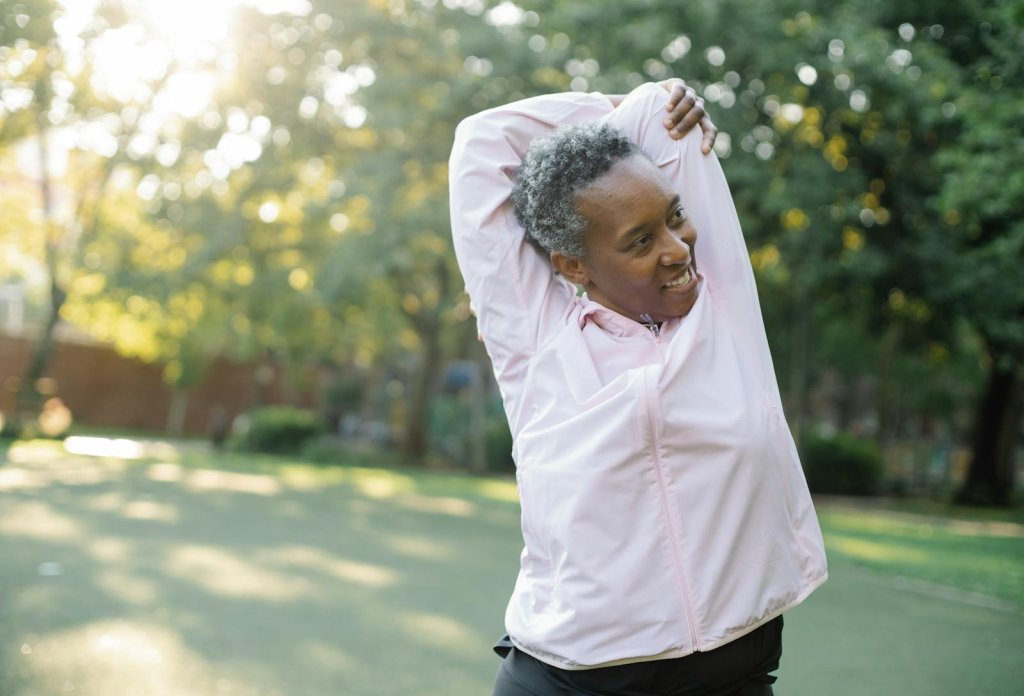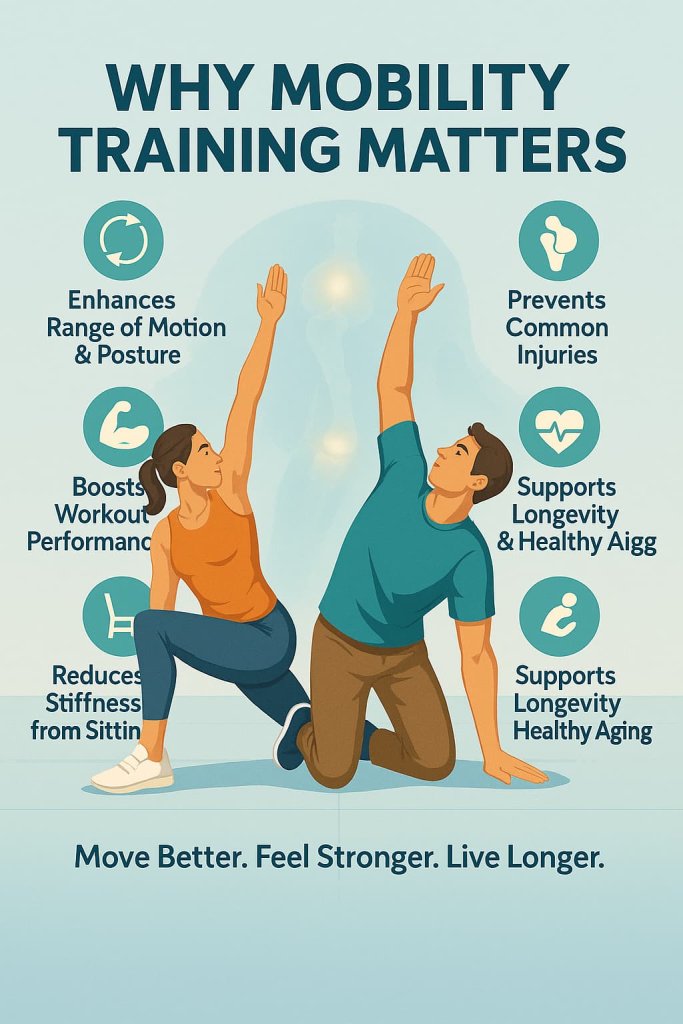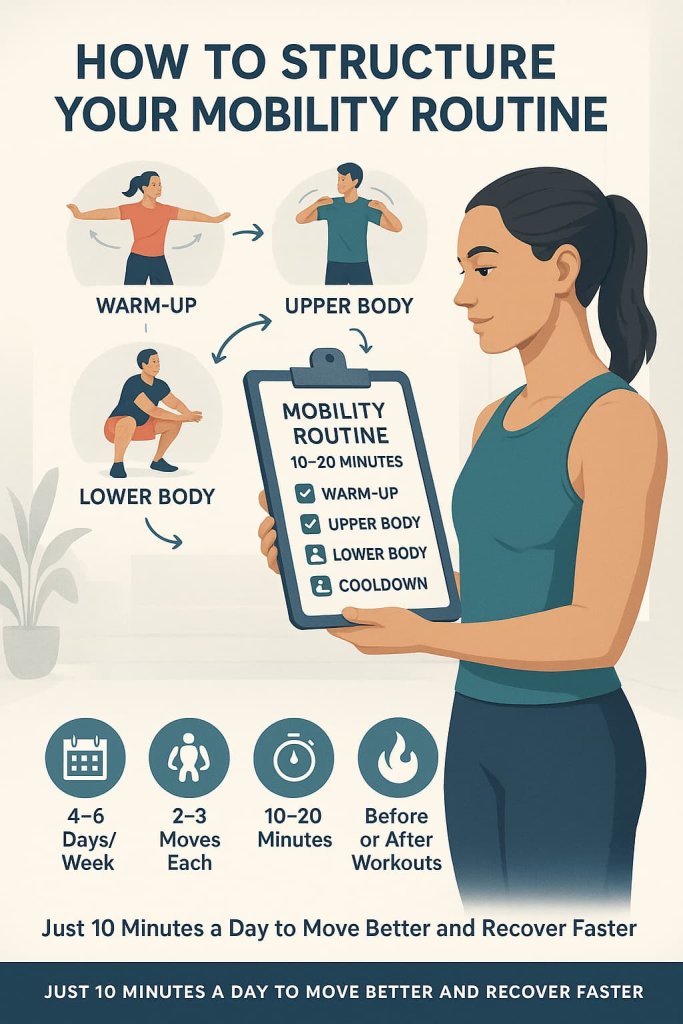Mobility exercises improve how your joints move through their full range of motion — helping you move better, feel stronger, and prevent injuries. Unlike flexibility, which focuses on stretching muscles, mobility combines strength, control, and movement quality.

Improving mobility supports everything you do — from lifting weights and running to sitting comfortably and maintaining good posture. According to peer-reviewed research, consistent mobility training enhances joint health, reduces stiffness, and supports long-term physical function. Whether you’re an athlete, desk worker, or fitness beginner, adding mobility work just 10 minutes a day can make a major difference.
Let’s explore the 20 best mobility exercises for your entire body, with step-by-step instructions and trainer-backed benefits.
Why Mobility Training Matters
Mobility is the foundation of strength, flexibility, and balance. According to the American Council on Exercise , good mobility allows you to perform daily tasks and workouts safely and efficiently by improving joint lubrication and reducing compensations that cause pain.

Key benefits:
- Enhances range of motion and posture
- Prevents common injuries (knees, shoulders, hips)
- Boosts workout performance
- Reduces stiffness from sitting or overtraining
- Supports longevity and healthy aging
How to Structure Your Mobility Routine
A balanced mobility routine takes just 10–20 minutes a day.

Do this:
- 4–6 days per week
- 2–3 upper-body + 2–3 lower-body moves per session
- Use before workouts (warm-up) or after (cooldown)
- Focus on smooth, controlled movement — not stretching forcefully
Trainer Tip: Warm up lightly first for better range and control.
20 Best Mobility Exercises to Move Better, Feel Stronger, and Stay Injury-Free
These 20 mobility exercises target every major joint — improving how you move, lift, and recover.
Practice them regularly to enhance flexibility, strength, and long-term joint health.
Upper-Body Mobility Exercises
1. Shoulder CARs (Controlled Articular Rotations)
Why it works:
Shoulder CARs are one of the most effective ways to maintain joint health and prevent shoulder impingement. They train your rotator cuff to stabilize through its full range of motion, which supports better posture, pressing mechanics, and injury prevention.
Muscles worked: Deltoids, rotator cuff (supraspinatus, infraspinatus, teres minor, subscapularis), lats, and scapular stabilizers.
How to do it:
- Stand tall with your core tight and one arm extended forward.
- Slowly raise the arm overhead while keeping your rib cage still.
- Begin rotating your arm inward as it passes overhead, making a full controlled circle backward.
- Return to the starting point, then reverse the motion.
- Perform 5–8 slow, pain-free reps in each direction.
Trainer Tip: Imagine drawing the biggest possible circle without moving your torso — control and joint tension are more important than speed.
2. Scapular Wall Slides
Why it works:
This move improves shoulder mechanics by retraining the scapula to glide smoothly against the rib cage. It counteracts the rounded-shoulder posture caused by prolonged sitting and screen time, restoring alignment between your neck, shoulders, and thoracic spine.
Muscles worked: Serratus anterior, rhomboids, middle trapezius, and rear deltoids.
How to do it:
- Stand with your entire back, head, and arms pressed flat against a wall.
- Bend elbows 90 degrees (like goalposts).
- Slowly slide your arms upward, keeping wrists, elbows, and shoulder blades in contact with the wall.
- Lower slowly to the starting position.
- Repeat 8–10 reps.
Trainer Tip: Keep your ribs down and avoid arching your back — small, controlled movements are best for retraining scapular control.
3. Cat-Cow Stretch
Why it works:
This yoga-based mobility exercise promotes spinal fluid movement and circulation between vertebrae, reducing stiffness in your back and improving core coordination. It also activates deep core stabilizers that support posture.
Muscles worked: Erector spinae, abs, lats, and spinal stabilizers.
How to do it:
- Begin on hands and knees in tabletop position.
- Inhale, arch your back, and lift your chest and tailbone (Cow).
- Exhale, round your spine, and tuck your chin toward your chest (Cat).
- Move fluidly through 8–10 cycles.
Trainer Tip: Focus on segmental movement — think of moving one vertebra at a time for deeper spinal awareness.
4. Thread the Needle
Why it works:
A top exercise for improving thoracic rotation, “thread the needle” releases tension in the upper back and shoulders while increasing mobility for overhead and rotational sports.
Muscles worked: Lats, rhomboids, posterior deltoids, and spinal rotators.
How to do it:
- From all fours, reach your right arm underneath your body toward the left.
- Allow your torso to rotate naturally until your right shoulder and ear touch the ground.
- Hold for 15–30 seconds, then return to start and switch sides.
Trainer Tip: Keep your hips square and stable to isolate rotation in your thoracic spine.
5. Arm Circles
Why it works:
A dynamic way to lubricate shoulder joints, improve blood flow, and prepare muscles for upper-body training.
Muscles worked: Deltoids, traps, rotator cuff.
How to do it:
- Stand with arms extended out to your sides.
- Make small forward circles for 30 seconds, then gradually increase size.
- Reverse direction for another 30 seconds.
Trainer Tip: Keep your shoulders relaxed and core tight — avoid shrugging.
Spine and Core Mobility
6. World’s Greatest Stretch
Why it works:
This compound mobility move targets multiple joints at once — hips, hamstrings, thoracic spine, and shoulders. It’s a proven warm-up for athletes, improving stride length, rotational control, and flexibility.
Muscles worked: Hip flexors, glutes, hamstrings, quads, adductors, and obliques.
How to do it:
- Step into a deep lunge with your right foot forward.
- Place your left hand on the ground and rotate your right arm up toward the ceiling.
- Feel the stretch through your chest and spine.
- Step back, switch sides, and repeat 6–8 reps total.
Trainer Tip: Keep your back leg straight and glutes engaged to deepen the hip stretch safely.
7. Seated Spinal Twist
Why it works:
Encourages rotation through the thoracic and lumbar spine, improving mobility and digestion while relieving lower-back stiffness.
Muscles worked: Obliques, erector spinae, glutes, and intercostals.
How to do it:
- Sit tall with both legs extended.
- Cross your right leg over your left and place your right hand behind you.
- Gently twist to the right using your left elbow against your knee for leverage.
- Hold for 20–30 seconds per side.
Trainer Tip: Grow taller through your spine as you twist — avoid forcing the rotation.
8. Standing Side Stretch
Why it works:
Loosens the obliques, ribs, and intercostal muscles that tighten from poor posture or sitting. Also enhances breathing mechanics and lateral stability.
Muscles worked: Obliques, lats, serratus anterior, intercostals.
How to do it:
- Stand with feet hip-width apart and knees slightly bent.
- Raise one arm overhead, reaching toward the opposite side.
- Keep your hips square and hold for 10–15 seconds.
- Repeat both sides 3 times.
Trainer Tip: Keep shoulders relaxed and focus on length, not how far you lean.
Hip and Lower-Body Mobility
9. 90/90 Hip Rotations
Why it works:
This exercise enhances internal and external rotation in your hips — key for squats, lunges, and athletic movement. It’s especially beneficial for those who sit for long periods.
Muscles worked: Glute medius, hip rotators, adductors.
How to do it:
- Sit on the floor with your front leg bent 90° and your back leg also bent 90°.
- Rotate your knees side to side slowly, switching positions.
- Keep your chest upright throughout.
Trainer Tip: If it’s too difficult, elevate your hips on a cushion for support.
10. Deep Squat Hold
Why it works:
Reintroduces natural hip and ankle range of motion lost through sedentary habits. Improves squat depth, pelvic control, and knee tracking.
Muscles worked: Quads, glutes, calves, adductors, core.
How to do it:
- Stand with feet shoulder-width apart.
- Sink into a deep squat, keeping heels flat and chest tall.
- Hold 30–60 seconds.
Trainer Tip: Grip a sturdy object if balance or ankle mobility limits you.
11. Hip Circles
Why it works:
Improves synovial fluid flow in the hip joint and strengthens stabilizers that control hip flexion and rotation.
Muscles worked: Glutes, hip flexors, core, and deep rotators.
How to do it:
- On all fours, lift one leg and make slow, wide circles outward.
- Then reverse the motion.
- Do 6–8 reps per direction.
Trainer Tip: Keep your back flat — movement should come only from the hip socket.
12. Lateral Lunge Stretch
Why it works:
Enhances side-to-side movement and opens the inner thighs, which are often tight from forward-only motion.
Muscles worked: Adductors, glutes, quads, and hamstrings.
How to do it:
- Step out wide to one side.
- Bend the working leg while keeping the other straight.
- Shift your hips back and feel the stretch.
Trainer Tip: Keep your foot flat and chest tall for balance.
13. Glute Bridge March
Why it works:
Combines hip mobility with strength, reinforcing glute activation and pelvic control — crucial for runners and lifters.
Muscles worked: Glutes, hamstrings, lower back, and abs.
How to do it:
- Lie flat on your back, knees bent.
- Lift hips until your body forms a straight line.
- Alternate raising one knee toward your chest at a time.
Trainer Tip: Maintain steady hips — no wobbling or arching.
Lower-Leg and Ankle Mobility
14. Ankle Circles
Why it works:
Prevents stiffness, enhances joint fluidity, and improves foot control for better balance.
Muscles worked: Calves, tibialis anterior, and intrinsic foot muscles.
How to do it:
- Lift one foot off the ground.
- Rotate your ankle slowly clockwise, then counterclockwise.
- Perform 10–12 reps per direction.
Trainer Tip: Keep motion slow and controlled — avoid jerky movements.
15. Calf Rock Backs
Why it works:
Improves dorsiflexion (forward ankle mobility), which helps your knees track properly during squats and lunges.
Muscles worked: Gastrocnemius, soleus, Achilles tendon, and tibialis anterior.
How to do it:
- Start in a half-kneeling position.
- Gently rock your knee forward over your toes without lifting the heel.
- Repeat for 10–15 reps.
Trainer Tip: Keep your front foot flat and pressure smooth — never bounce.
16. Heel-to-Toe Walks
Why it works:
Develops balance, ankle stability, and coordination while reinforcing proper gait patterns.
Muscles worked: Calves, tibialis anterior, and stabilizers of the feet.
How to do it:
- Stand tall and walk slowly forward, rolling from heel to toe.
- Continue for 10–15 steps forward and backward.
Trainer Tip: Keep your steps light and deliberate to engage stabilizing muscles.
Full-Body Mobility and Flow
17. Downward Dog to Cobra Flow
Why it works:
This fluid transition stretches your posterior chain (back side of the body) while activating core and shoulder stability.
Muscles worked: Hamstrings, calves, spine, shoulders, and chest.
How to do it:
- Begin in plank, push hips back into Downward Dog.
- Slowly shift forward into Cobra, opening the chest.
- Repeat for 6–8 smooth rounds.
Trainer Tip: Breathe deeply — inhale in Cobra, exhale into Downward Dog.
18. Standing Toe Touch to Overhead Reach
Why it works:
Improves spinal articulation and hamstring flexibility while promoting coordination between upper and lower body.
Muscles worked: Hamstrings, erector spinae, deltoids.
How to do it:
- Stand with feet hip-width apart.
- Hinge forward to touch your toes.
- Sweep arms overhead and stand tall.
- Repeat for 10–12 reps.
Trainer Tip: Move with rhythm — flow through each rep instead of pausing.
19. Hip Flexor Stretch with Reach
Why it works:
Releases tight hip flexors, counteracting the effects of sitting and improving hip extension for better stride mechanics.
Muscles worked: Hip flexors, quads, and lower abs.
How to do it:
- Kneel on your right knee, left foot in front.
- Shift hips forward until you feel a stretch in the front hip.
- Raise both arms overhead and hold 20–30 seconds.
Trainer Tip: Squeeze your glutes gently to stabilize your pelvis and deepen the stretch safely.
20. T-Spine Rotation (on all fours)
Why it works:
Restores upper-back mobility, essential for healthy posture and overhead movement. Poor thoracic mobility often causes shoulder or neck discomfort.
Muscles worked: Thoracic extensors, spinal rotators, obliques, and shoulders.
How to do it:
- Start on all fours with one hand behind your head.
- Rotate your upper body, aiming your elbow toward the ceiling.
- Return and repeat 8–10 times per side.
Trainer Tip: Keep your lower back neutral — movement should come only from your upper spine.
How Often Should You Do Mobility Workouts?
Mobility training is safe to do daily, but consistency matters more than intensity.
Guidelines:
- Beginners: 3–4 days/week
- Intermediate: 4–6 days/week
- Advanced: Daily (10–15 minutes)
Trainer Tip: Morning or post-workout mobility boosts recovery and reduces stiffness.
FAQs
1. What’s the difference between flexibility and mobility?
Flexibility is muscle length; mobility is active control of joint movement.
2. How long should a mobility session last?
10–20 minutes is effective when done consistently.
3. Can I do mobility exercises every day?
Yes — daily mobility work improves recovery and reduces stiffness.
4. Do I need equipment?
No — bodyweight is enough, though bands or foam rollers can enhance results.
5. When’s the best time to do mobility work?
Before workouts (as dynamic warm-up) or after (as cooldown).
6. Can mobility help with back pain?
Yes, improving hip and spine mobility often reduces lower-back discomfort.
7. How soon will I see results?
You may notice improved movement in 1–2 weeks with consistency.
Conclusion
Mobility training is not optional — it’s essential for longevity, strength, and pain-free movement. Adding these 20 best mobility exercises into your daily or weekly routine can transform how you move, lift, and feel every day.
Start with 10 minutes today — your body will thank you tomorrow.
References
- Warneke, K. et al. (2023). Systematic review: daily stretching (10–60 min) improves ROM.
https://pmc.ncbi.nlm.nih.gov/articles/PMC10124737/ - Warneke, K. et al. (2022). Ten-minute home mobility/stretching preserves flexibility and function.
https://pmc.ncbi.nlm.nih.gov/articles/PMC9741422/ - Garber, C. E. et al., ACSM Guidelines (2011). Evidence-based flexibility/mobility frequency and safety.
https://pubmed.ncbi.nlm.nih.gov/21694556/ - Harvard Health (2025). Practical guidance on stretching timing, duration, and form.
https://www.health.harvard.edu/staying-healthy/the-ideal-stretching-routine
